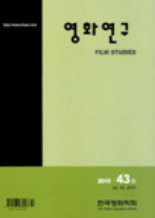- 영문명
- Cinematic Experience of ‘New Order in East Asia’: Japanese Imperial Propaganda Films on Joseon-Manchuria Tourism
- 발행기관
- 한국영화학회
- 저자명
- 김한상
- 간행물 정보
- 『영화연구』제43호, 81~114쪽, 전체 34쪽
- 주제분류
- 예술체육 > 예술일반
- 파일형태
- 발행일자
- 2010.03.31
6,880원
구매일시로부터 72시간 이내에 다운로드 가능합니다.
이 학술논문 정보는 (주)교보문고와 각 발행기관 사이에 저작물 이용 계약이 체결된 것으로, 교보문고를 통해 제공되고 있습니다.

국문 초록
영문 초록
In late 1930s, while the Japanese Empire declared for the 'New Order in East Asia' which was a geopolitical point of view uniting Colonial Korea (Joseon), Manchuria and China under the Japanese imperial umbrella, there also emerged a considerable quantity of propaganda films corresponding to that idea. Several governmental agencies and transportation companies made plans for and invested in making promotional films dealing with tourism around these regions. This article examines one of such films named Tokyo-Peking: through Tyosen and Manchoukuo (1939), which I discovered from the Toho Stella Company's Nichiei Archive and could get an offer to use in this research. Tokyo-Peking is composed of three chapters describing three regions of Joseon (“Tyosen”), Manchuria (“Manchoukuo”) and North China. Each chapter shows different local identity of each specific region, but three of them constitute a bigger superordinate regional image of East Asia, which finally resolves itself into the portrait of the Japanese Empire. The mechanism of this synthesis is situated in that of the locomotive. Cartographic overview of railway travelers' map as the animated opening logo of each chapter shows the visual logic of calculable 'World', and the journey-like formality made up of start-move-arrive motions forms a new sense of place which leaves out and forecloses in-between places. Places remain only as split pieces of stereotypical localities, and their oriental images are combined to the diversity of the modern nation-state by juxtaposing them with the spectacles of industrial modernization. This composition shows, in one sense, the counter geopolitical images against the West, but, at the same time, it completes the future images of the modernized nation-state. And the cinematic experience of this sort of tourist propaganda films could be disciplinary moments producing the pseudo-imperialistic subjectivity. However, we should also consider the potentialities of the cinema which could be a sphere of negotiation between presenters and audiences. For instance, there are some moments of reverse gaze in tourist films, and indecipherable scenes of aboriginal subjects murmuring or unfastening non-languages. They are testifying the moments of transito which erode the assumption of singular cause-and- effect relationship between propagandists and the propagandized.
목차
1. 1930년대 후반의 관광 문화영화
2. 관광 문화영화 장르와 시각주의
3. ‘동아신질서’의 심상지리와 영화 〈동경-북경〉
4. 제국을 여행하는 관광객으로의 시각적 훈육
5. 프레임의 바깥, 초-감각적 세계상과 잔여물
6. 나가며-식민지 관광 문화영화의 극장경험
키워드
해당간행물 수록 논문
- 영화 <밀양>과 소설 <벌레 이야기>의 서사 전략에 대한 비교 연구
- 유니버설 스튜디오와 디즈니랜드의 영화콘텐츠 활용연구
- 조선-만주 관광 문화영화와 ‘동아신질서’의 극장 경험
- 다큐멘터리와 아방가르드의 접점에서
- 가족을 대상으로 하는 사적 다큐멘터리에서 제기되는 윤리적 쟁점
- 구로사와 아끼라 영화의 마지막 결투 장면 연출 분석
- 한국영화산업 보호정책의 평가와 과제
- 해방기 영화운동과 조선영화협단
- 로베르 브레송과 다르덴 형제 영화의 유사성 연구
- 다큐멘터리란 무엇인가
- 문예영화 <안개>의 근대적 주체성 비판
- 이행적 친일영화(1940~1943)로서 <집 없는 천사>의 이중 의식에 대한 연구
- 중국의 한국영화 수용에 대한 연구
- 사단법인 한국영화학회 정관 외
- 영화적 공간의 확장에 대한 연구
참고문헌
관련논문
예술체육 > 예술일반분야 BEST
- 생성형 AI 도구와 디자이너의 협업 프로세스 개발 - 이미지를 통한 아이디어 확산에서 고해상도 렌더링까지
- 영화 [올드보이]와 소포클레스 「오이디푸스 왕」의 상동성 연구
- ‘일과 삶의 균형(Work-Life Balance)’ 척도 개발을 위한 연구
예술체육 > 예술일반분야 NEW
- Z세대 생활체육 동호인들의 SNS 중독 경향성과 불안정 성인애착이 완벽주의적 자기제시 및 우울에 미치는 영향
- 즐거움과 몰입을 통한 수익성 기대가 NFT 구매 의도에 미치는 매개효과 분석: UTAUT2와 합리적 무관심(RI)을 중심으로
- 생태체험이 청소년의 자연친밀감, 환경태도, 환경행동의도에 미치는 영향
최근 이용한 논문
교보eBook 첫 방문을 환영 합니다!

신규가입 혜택 지급이 완료 되었습니다.
바로 사용 가능한 교보e캐시 1,000원 (유효기간 7일)
지금 바로 교보eBook의 다양한 콘텐츠를 이용해 보세요!



